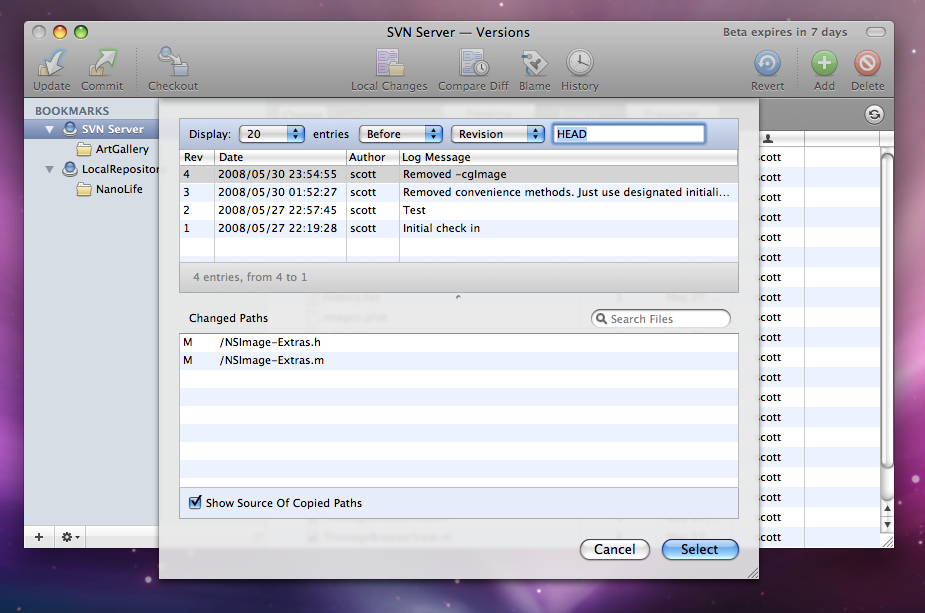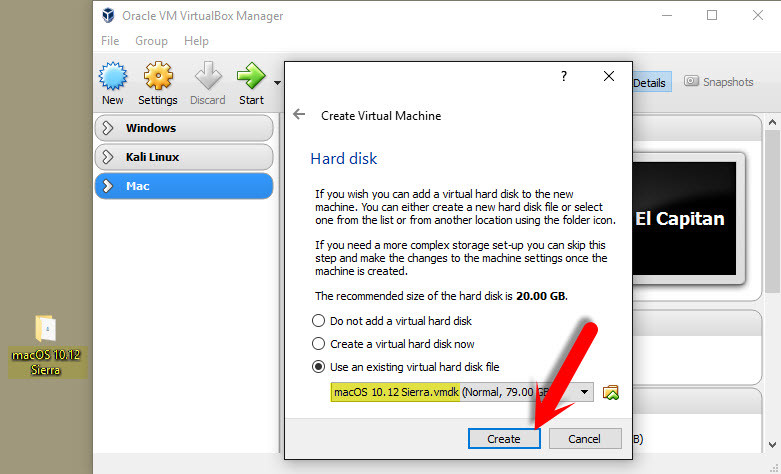May be related to and/or duplicate of #11401, #11288, #11052, #10998. #10998 seems to have the most discussion and some folks are having success rolling back to VB 4.1 from 4.2 to allow Mac OS X. Jun 07, 2019 Decide whether you want a dynamically allocated or fixed size virtual hard drive. A dynamically allocated drive will start small and grow in size as more space is needed. Osx86 can run on non-Intel x86 CPUs even if vanilla Mac OS X cannot. Re: Joe: Yes, it may violate a licence agreement from Apple but I am not aware of Apple suing an. While installing macOS specifically Mojave is pretty easy on an actual Mac, but if you are a Windows user, that is not the case. If you are a Windows user who wants macOS for some reasons, however, you can, but there’s a whole lot to do.
ExpressVPN is widely known as the fastest and most secure VPN in the industry. With over 3,000 servers in 90+ countries, it is capable to unblock all geo-blocked services including Netflix, Amazon Prime Video, HBO+, and BBC iPlayer.
ExpressVPN app is available for nearly all the devices including Windows, macOS, Android, iOS, browsers, Firestick, and gaming consoles.
Mac OS X El Capitan was released last year. The operating system boasts of great features and a streamlined user experience. Fortunately, this incredible operating system by Apple is available for download. But you are wondering why this information is relevant to you since you have a PC, not a Mac. Well, read on to learn how you can install Mac OS X El Capitan on PC without a Mac, using VirtualBox.
- Select to create a new virtual hard drive, then choose Continue again. Back at the primary VirtualBox screen, choose “Start” to boot the new Windows 10 volume. Since there is no drive or OS installed yet, you will be asked to choose a virtual optical disk, click on the Folder icon and choose the Windows 10 ISO, then click “Start.”.
- Jun 05, 2019 The reason for this issue is because there do not has partition on the virtual disk, so we should first create a partion on the virtual disk, then you can select the virtual disk partition to install mac os. Click Install macOS High Sierra — Quit Install macOS menu item in top left corner to quit mac os installation wizard.
- In this article, I’m going to show you the complete guide to fix VirtualBox errors while installing Mac OS X. Most of the website that creating content regarding the installation of Mac OS X El Capitan or macOS Sierra on VirtualBox is not complete and have errors.
Virtual Box

VirtualBox is a virtualization software that enables an operating system to run as a program or application. VirtualBox allows operating systems to be installed on it, by creating a virtual machine.
Requirements to install Mac OS X El Capitan on PC
The process of installing this operating system on PC requires VirtualBox. VirtualBox is free for download. You will also need the downloaded image file of the OS (Google drive file courtesy tactig.com). You will need an extraction software such as Winrar to extract the OS.
There are system requirements for this process. You need Windows 7 or a newer version of Windows. The BIOS of your PC ought to be virtualization enabled. There needs to be free disk space of at least 3GB.
Step-by-step Guide to install Mac OS X on PC using VirtualBox
Step 1: Install VirtualBox
If you do not have VirtualBox, download and install it from this link. The installation process should be easy. After downloading, click on the setup and follow the prompts as required.
Step 2: Extract Mac OS X El Capitan
The image file you downloaded from Google drive (downloaded image file of the OS) needs to be extracted using WinRAR. You will simply have to right click on the image file and select the option ‘Extract Here’.
Step 3: Open VirtualBox and create a Virtual Machine
- This whole process is dependent on VirtualBox. Open the application and select ‘New‘. In this case, we will name the new machine ‘OS X El Capitan’. After naming the machine click ‘Next‘.
- On the next window choose the amount of RAM you want for your virtual machine. The virtual machine will need at least 2GB RAM. After choosing the desired RAM click ‘Next’.
- You will now be required to select the hard drive. You should check the option that states ‘Use existing virtual hard drive file’. The file you are referring to in this case is the OS X El Capitan image file, you extracted from the step 2, above.
Step 4: Edit the new virtual machine

- There are three main properties of your virtual machine that you will need to edit. When you open the virtual machine you created, head to ‘Settings‘.
- Open the ‘General‘ tab. Here, set everything to default.
- Open the next tab, which is ‘System’. Here, there are three tabs which are horizontally arranged. The first is ‘Motherboard’ Disable Floppy, Enable EFI and select the Chipset PIIX3 or IHC9.
Step 5:Add Code to VirtualBox with Command Prompt
- Run command prompt on your PC as the administrator.
- You will have to add code to VirtualBox using Command Prompt. Copy the code given below and paste it in Command Prompt.
- Note: In the code given below replace the words ‘Your VM Name’ with the name you gave your virtual machine.
For VirtualBox 5.0;
cd 'C:Program FilesOracleVirtualBox'VBoxManage.exe modifyvm 'Your VM Name' --cpuidset 00000001 000106e5 00100800 0098e3fd bfebfbffVBoxManage setextradata 'Your VM Name' 'VBoxInternal/Devices/efi/0/Config/DmiSystemProduct' 'iMac11,3'VBoxManage setextradata 'Your VM Name' 'VBoxInternal/Devices/efi/0/Config/DmiSystemVersion' '1.0'VBoxManage setextradata 'Your VM Name' 'VBoxInternal/Devices/efi/0/Config/DmiBoardProduct' 'Iloveapple'VBoxManage setextradata 'Your VM Name' 'VBoxInternal/Devices/smc/0/Config/DeviceKey' 'ourhardworkbythesewordsguardedpleasedontsteal(c)AppleComputerInc'VBoxManage setextradata 'Your VM Name' 'VBoxInternal/Devices/smc/0/Config/GetKeyFromRealSMC' 1
For VirtualBox 4.0;
cd 'C:Program FilesOracleVirtualBox'VBoxManage.exe modifyvm 'Your VM Name' --cpuidset 00000001 000306a9 04100800 7fbae3ff bfebfbffVBoxManage setextradata 'Your VM Name' 'VBoxInternal/Devices/efi/0/Config/DmiSystemProduct' 'MacBookPro11,3'VBoxManage setextradata 'Your VM Name' 'VBoxInternal/Devices/efi/0/Config/DmiSystemVersion' '1.0'VBoxManage setextradata 'Your VM Name' 'VBoxInternal/Devices/efi/0/Config/DmiBoardProduct' 'Iloveapple'VBoxManage setextradata 'Your VM Name' 'VBoxInternal/Devices/smc/0/Config/DeviceKey' 'ourhardworkbythesewordsguardedpleasedontsteal(c)AppleComputerInc'VBoxManage setextradata 'Your VM Name' 'VBoxInternal/Devices/smc/0/Config/GetKeyFromRealSMC' 1
Step 6: Install OS X El Capitan in your virtual machine
- Your virtual machine is now ready for the new OS. Open VirtualBox and click ‘Start’. A code will run on the screen.
- After the code, you are ready to install the Mac OS X El Capitan. The installation process is very simple. It involves creating a new user account, selecting region, time and language preferences.
- After the installation, you can now run the OS X El Capitan on virtualBox on a PC.
Installing Mac OS X El Capitan on PC using VirtualBox will break some sweat. But considering the usability of the OS, it is worth the time. In case you encounter problems following this guide, feel free to use the comment sections.
OS X Lion virtual machine
The current Mac computer family is based on Intel x86-64 platform and also Mac OS X is optimized for current Intel processors. The only difference between IBM-PC and Macintosh lies in a special EFI BIOS that identifies that is needed for Mac OS X. However, third party developers established project called OSx86, better known as Hackintosh, which allows users to run Mac OS X on non-Apple computers, or in virtualization software.
So let's see how you can run latest Mac OS X Lion in virtual machine created in Oracle VM VirtualBox virtualization software.
How to install Mac OS X Lion to VirtualBox
Step 1 - Install VirtualBox to your computer
You can download free VirtualBox installation package from Oracle website. It has very straightforward installation without any complex settings.
Step 2 - Mac OS X distribution
They are few ways how to install Mac OS X to virtual machine. Advanced users can use original DVD with special boot loaders and test optimal settings for the best Mac OS X performance.
However, we used easier way with a pre-prepared installation image called iATKOS L2, that includes Mac OS X Lion and other utilities, patches as well as hardware drivers that allows users to install Mac OS X. You can Google for it and download it, for example on BitTorrents. Original iATKOS L2 is distributed in DMG format used for Mac OS X installation packages.
Step 3 - Create virtual machine
After you have installed VirtualBox and downloaded iATKOS L2 disk image, it is time to prepare the virtual machine.
To run Mac OS X in virtual machine you need to have processor with Intel VTx, or AMD-v hardware virtualization support. If you don't have it you can also try to install Hackintosh directly to your computer. Read How to create Hackintosh here.
StartVirtualBox and click on New option in the top menu. In welcome screen of the virtual machine wizard, click on Continue button.
Set the VM Name. SetOS Type to Mac OS X and set Version to Mac OS X Server or Mac OS X Server 64 on 64-bit systems (standard Mac OS X is not officially supported in VirtualBox). Click on Continue button.
Specify the name and type of OS
SetBase memory (RAM) to minimum of 1GB, if you can afford it set it to 2 or more.
Set the RAM size
In next Virtual Hard Disk screen uncheck the Start-up disk box → Click on Continue button. You will be warned by message, but ignore it and press again Continue button.
Warning message in VirtualBox wizard
In Summary window click on Create button and new virtual machine will be added to the VirtualBox virtual machine list.
Virtual Machine summary window
Step 4 - Virtual machine settings

Right click on new virtual machine and selectSettings option in pull down menu. Go to the System tab and uncheck box with Enable EFI option.
VirtualBox virtual machine settings
Click on Display tab and setVideo Memory to 128MB and check the box Enable 3D Acceleration.
Virtual machine video settings
Click on Storage tab → Click on hard drive icon next to IDE Controller option → SelectCreate new disk.
VirtualBox create a new virtual hard drive
In simple virtual disk creation wizard selectVDI (Virtual Box Disk Image) option and click on Continue button → Storage details set to Dynamically allocated and click on Continue button → Set the name, location and size of virtual disk and click on Continue button (min. 15GB recommended) → On summary window click on Create button.
Now you are back to the Storage settings. Click on 'Empty' optical drive → Click on Optical Disk icon in the Attributes area → click on Choose a virtual CD/DVD disk file... and select iATKOS L2 image. Now click on Open button and after that OK button.
Mount CD/DVD image in VirtualBox
Step 5 - Installing Mac OS X
Now the virtual machine is prepared for Mac OS X installation. Double click on new virtual machine and wait until the Mac OS X installation application started.
Select your language and click on Next arrow.
Mac OS X installation application
Now you need to prepare installation partition on virtual disk. Click on Utilities option in Top menu and selectDisk Utility.
Mac OS X Installer Utilities
Select VBOX HARDDISK in Hard Drive list → Select Erase option → Format - Mac OS Extended (Journaled) → set the name of disk and click on Erase... button. Wait until formatting is finished and close the Disk Utility.
Mac OS X Disk Utility
Mac Os X Not Found Drive In Virtualbox 1
You are back in the Mac OS X installation wizard → Click continue button and Agree with Read Me.
Select the installation hard drive and click on Install button. Now it is time for a break and wait until the installation process will be finished.
Mac OS X installation partition
After successful installation, the virtual machine will be restarted. If after restart the machine doesn't reboot, simply close the machine and select power off machine and start machine again.
Mac OS X install succeeded
After reboot, or restart you will see an Chameleon bootloader. PressF8 key to open boot option and select by arrow key bootable partition with new installed Mac OS X and press Enter.
iATKOS Chameleon bootloader
Wait until the Mac OS X will start Computer Setup Wizard, where you set configuration of your Mac like region, keyboard type, Apple ID, registration, computer account etc.
After the settings are complete you will be welcomed to Mac OS X Lion desktop.
Mac OS X Lion installed in VirtualBox
If you don't want to always use a mounted iATKOS installation image to boot up the system, go the System Preferences → Boot Loader → Boot Setup → check the Default Partition box and type to text box hd(0,2) to set bootable partition and close Bootloader Configuration. Now the system is able to boot without bootable image.
Chameleon Bootloader Configuration app in System Preferences
And that's it. You can now start to learn with Mac OS X operating system, install and test Mac applications as well as develop applications for Mac, iPhone or iPad with Xcode.
Mac Os X Not Found Drive In Virtual Box Office
Screenshots in this article are from VirtualBox for Mac, but the same settings are working for VirtualBox for Windows and Linux.